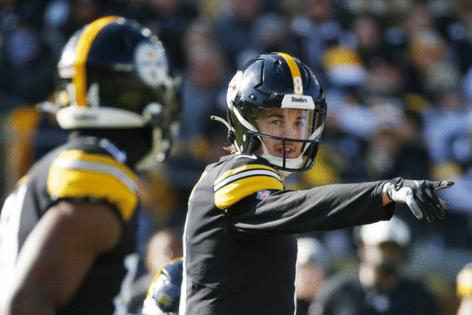Analysis: Steelers' period of stagnation directly correlates to NFL draft struggles
Published in Football
PITTSBURGH — A week from now, there will be instant reactions to how the Steelers and other teams executed the NFL draft. Winners and losers will be declared, grades will be assigned and some teams will be skewered for their selections.
But it takes three to five years to accurately evaluate a draft class, and there are different benchmarks in the industry for what constitutes a good draft.
Daniel Jeremiah is the lead draft analyst for the NFL Network, but he got his start in the league as a scout with the Ravens, Eagles and Browns. In his experiences, he said it’s a simple matter of landing players who develop into starters, but that’s often easier said than done.
“I think you look at the number of starters you get in a draft,” Jeremiah said. “Three is the target. If you get four, that’s outstanding.”
Local draftnik Anthony Villiotti developed a slightly different grading system in his latest research that he shares on his X handle @draftmetrics. In his latest project, Villiotti analyzed the draft picks for all 32 NFL teams from 2012-22 with the intent of grading draft classes over time.
If a draft pick developed into a three-year starter, Villiotti deems that pick a success. Thus, his success rate is determined by the number of three-year starters divided by the team’s selections.
It’s too early to judge Omar Khan’s first two drafts, but his research dovetails nicely with former general manager Kevin Colbert’s final years as on the job. Colbert oversaw the Steelers’ drafts for 23 years from 2000-22.
For the 11-year span from 2012-22, the Steelers had a 27% success rate, which was below the league average, ranking 20th among the 32 teams.
Villiotti broke down the picks by round, and the Steelers also were below average on their success rate for first- and second-round picks, the two rounds where teams find most of their starters. They had a 60% success rate in those rounds compared to the league average of 62.5%.
Colbert’s drafts in his first 12 years as GM were annually among the best in the league. Using Jeremiah’s standard of finding three starters in any given draft, Colbert achieved that more often than not. In 2002, regarded as one of his top drafts, he landed five starters, including offensive lineman Kendall Simmons, receiver Antwaan Randle El, safety Chris Hope, inside linebacker Larry Foote and defensive lineman Brett Keisel.
Colbert’s draft in 2010 might have been better in terms of the impact the starters made. Center Maurkice Pouncey was the first-round pick, and Colbert also landed outside linebacker Jason Worilds in the second round and receivers Emmanuel Sanders and Antonio Brown in the third and sixth rounds, respectively.
It was rare for Colbert to miss on first- or second-round picks in the first half of his career. From 2000-12, Colbert hit on all of his first-round picks, a run that set up the Steelers for their fifth and sixth Super Bowl titles.
Colbert drafted Hall of Famers Troy Polamalu and Ben Roethlisberger in back-to-back years in 2003 and 2004. Heath Miller, the best tight end in franchise history, was the No. 1 pick in 2005 and Super Bowl MVP Santonio Holmes in 2006.
That’s how championship teams are built. Colbert didn’t have one failed first-round pick in his first 12 drafts. All of them were starters and most long-time contributors toward the team’s success.
And Colbert continued his success after those Super Bowl wins when he selected Pouncey and Cam Heyward in consecutive years, setting the team up for another sustained run for the next decade.
Colbert’s only bad misses in the first half of his tenure came in the second round, and they were few and far between. There was linebacker Alonzo Jackson in 2003, cornerback Ricardo Colclough in 2004 and receiver Limas Sweed in 2008.
That’s an incredible success rate of 86% for first- and second-round picks in that 12-year span.
But even those few misevaluations were far outnumbered by the ability to find mid- and late-round gems. Brown might be his best pick considering the draft slot, but he also found longtime starters and contributors in the middle and later rounds.
The value in landing those players oftentimes is overlooked, but they’re just as important in building a championship-caliber roster.
And sometimes those mid- and late-round picks flourish elsewhere if your roster is stacked. Offensive lineman Kelvin Beachum was one of the final picks in the seventh round of the 2012 draft. He only played four seasons with the Steelers, but he’s still playing today. He signed another contract with the Cardinals earlier this month.
“We would also look at who was still in the league,” Jeremiah said. “We would do studies on that. Even if they still weren’t with your team, you evaluated them correctly and it proves you’re doing it the right way.”
One can argue no GM had a better 12-year run than Colbert did during that span.
The recent struggles with the franchise can at least in part be tied to a decline in evaluating and drafting from 2013-22. Colbert had a couple of great first-round picks in David DeCastro (2012) and T.J. Watt (2017), but there were a lot of first-round picks that never panned out.
There was Jarvis Jones in 2013, Artie Burns in 2016, Terrell Edmunds in 2018, Devin Bush in 2019 and Kenny Pickett in 2022, his final first-round choice. Colbert went from batting 1.000 with his top picks in the first half of his tenure to close to .500 in the second half of his tenure.
Colbert had two great second-round picks in Le’Veon Bell and Stephon Tuitt in 2013, but there also was Mike Adams, Senquez Golson and Chase Claypool.
It’s too early to evaluate the first two drafts of Omar Khan’s tenure, but the upcoming season will be big in that eventual evaluation. His first draft in 2023 hinges on the development of offensive lineman Broderick Jones, cornerback Joey Porter Jr. and defensive lineman Keeanu Benton.
All three will be three-year starters this season, but the quality of their play has fluctuated, especially Jones, whom they traded up to get with the No. 14 selection in the draft. He’s moving to his natural left tackle position after spending his first two seasons at right tackle. Porter encountered some struggles last season, and Benton, while showing some flashes, hasn’t developed into a future cornerstone on the defensive line.
©2025 PG Publishing Co. Visit at post-gazette.com. Distributed by Tribune Content Agency, LLC.







Comments